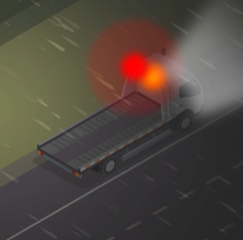The consultation phase for the issuing of licenses for the tyre and rescue, breakdown and recovery industry to use red lamps has recently closed. PROSE are now liaising with the Department for Transport and progressing this issue to ensure that such use can be implemented as soon as possible.
Thank you to all who participated and contributed to the consultation.
The tyre and rescue and recovery industry have been granted permission to use rear-facing red flashing lamps. After a campaign of approximately 35 years.
Prior to this decision, the only industries able to use red-flashing lamps were Government Agencies, Police and National Highways Traffic Officers. So, it is a privilege to finally be awarded the right alongside these sectors.
In order for the lamps to maintain their effectiveness, tyre, rescue and recovery industries need to be professional enough to understand that they cannot and should not be used at every tyre/breakdown/recovery incident. In other words they should be used only following the results of a dynamic risk assessment determining extenuating factors.
PROSE
Operating protocols have been drafted and approved in principle by the Professional Recovery Operators Safety Executive (PROSE) which includes; National Tyre Distributors Association (NTDA), Institute of Vehicle Recovery (IVR), National Highways, National Police Chief’s Council (NPCC), National Fire Chief’s Council (NFCC) and the UK Rescue Organisation (UKRO). The same principles on red flashing lamp use go across the board, for all agencies that have permission to use them to make their use the most effective.
PROSE encompasses the experience of those agencies, as well as the current national training/licencing scheme administrators and guardians of the professional registers for the tyre, rescue and recovery sectors (REACT and the Institute of Vehicle Recovery), so PROSE is well placed to ensure that red lamp standards and guidance protocols are set at the correct level for maximum safety and effectiveness, especially when it comes to staff being properly trained and competent in their use.
The final stage is wider consultation and for the principles of the final document to be shared with the Department for Transport.
AMBER BEACONS
In order to correctly use red flashing lights, tyre, rescue and recovery industries need to be clear on the purpose and use of their current staple – amber beacons therefore this has been made part of the protocol.
REAR-FACING RED FLASHING LAMPS
The provisos for using red flashing lamps is clearly laid out by the DfT:
That they be rear-facing only
That they have a flash rate of between 60 and 240 equal times per minute
That the intervals between each display of lights shall be constant
That they are linked to a functioning vehicle interlock which permits their activation only when the vehicle is stationary and automatically deactivates them when the vehicle reaches a speed exceeding 5 mph.
That their use be limited to times when the vehicle is used in connection with, and in the immediate vicinity of an accident or breakdown.
Prior to the regulation expected in 2025, a Vehicle Special Order must be sought from the DfT before rear-facing red lamps can be used, it is illegal to use them without the VSO.
The industry has also set its own professional standards to ensure that its use of red flashing lamps is most effective and that the protocols align with the other sectors granted to use them:
Use only when it is necessary or desirable to warn motorists of the presence of breakdown operators or tyre technicians working on or near a live carriageway.
Their use should be limited to mainly hard shoulders and fast-moving carriageways.
Whilst parked on a hard shoulder in normal circumstances rear-facing red flashing lamps would not be required unless the operators dynamic risk assessment highlights one or more mitigating factors e.g. poor visibility due to very poor weather conditions.
Their use would only be following a dynamic risk assessment and if they are used the reason for their use must be recorded. This goes across all the industries that have permission to use rear facing red flashing lamps.
Only those companies whose staff have been fully trained in their use, should receive a vehicle special order i.e. those who are NTDA REACT trained and licenced or National Highways Sector Scheme 17/17B trained.
CONSULTATION ON THE USE OF REAR-FACING RED FLASHING LAMPS AND APPROPRIATE PROTOCOLS
The Department for Transport (DfT) intend to issue Vehicle Special Orders (VSOs) for all rescue and recovery operators and tyre sector personnel who wish to use rear-facing red lamps prior to primary legislation being introduced for the sector.
As the wider industry safety executive PROSE is gathering feedback from sector stakeholders for both tyre and recovery sectors on the Use of Amber Warning Beacons and Rear-Facing Red Flashing Lamps Protocol and the Applying for Rear-Facing Red Flashing Lamps Protocol. Please find enclosed the draft protocols, you will need to view these before answering the consultation questions
